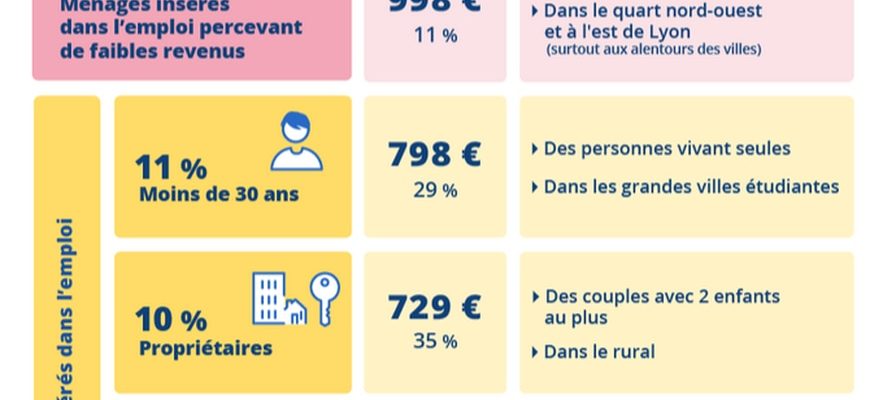Two weeks after the announcement of the launch of the government’s new anti-poverty plan, the National Institute of Statistics and Economic Studies (Insee) published this Tuesday, October 3 a typology of poor households In France. The country currently has more than 9 million poor people, as many people who have a standard of living below 60% of the median income. For a single person, this threshold is set at around 1,100 euros per month. The share of poor people has remained relatively stable for around twenty years, and stands at around 14%.
According to data collected by INSEE, poor households can be grouped into six categories, which each respond to variable parameters, for example place of residence, situation on the labor market and household composition. A typology that allows us to see the diversity of households affected by poverty.
The six profiles of poor households according to INSEE.
© / INSEE
More than one in two poor households is far from employment
Among the six categories of poor households drawn up by INSEE, four bring together families who are not employed, whether they are unemployed, not working or still studying. These four types of households represent 55% of poor households, and are on average poorer than the others: while poor households made up of retired people have an income of 945 euros, poor people far from employment and tenants of the private park receive on average 807 euros.
Conversely, nearly one poor household in two is not far from employment: retirees represent more than a quarter of poor households, and nearly one poor household in five is made up of people occupying a low-paid employment. The latter are also more frequently made up of families with children.
Young people affected by poverty
11% of poor households are also made up of people under the age of 30, not in the labor market, and most often living in large student towns. A situation which affects both students and young people having difficulty finding employment, and which has resulted in increased use of food banks. The phenomenon, particularly visible during the Covid crisis, has since continued.
To try to provide solutions to young people and students in precarious situations, certain territories have put in place financial aid for young people who do not have access to social minimums (the RSA is reserved for those over 25). Since July 2022, the Loire-Atlantique department has been offering a “youth income” for 18-24 year olds, subject to resource conditions.
Three quarters of poor households live in cities
Poor households are over-represented in cities compared to the average French household: almost three quarters of them reside in urban areas. This presence is however not homogeneous across the territory, a concentration is observed in particular overseas, in the north of France, in the department of Seine-Saint-Denis and in the Mediterranean arc.
If not all French municipalities respect this obligation, towns belonging to large urban areas are subject to obligations regarding the construction of social housing, a constraint which does not weigh on rural municipalities. When it comes to poor households living in rural areas, they are more often retired people, living alone, or couples with one or two children.
One in ten poor households owns
The typology established by INSEE also shows that a portion – a minority – of poor households has access to property. Essentially in rural areas, and made up of people far from employment, these households are also the poorest of the six distinct categories. They live on average on 729 euros per month per consumption unit (one consumption unit being allocated to an adult in the household, then 0.5 unit per person over 14 years old and 0.3 unit per person under 14 years). This amount is 35% lower than the poverty threshold established by INSEE.
